

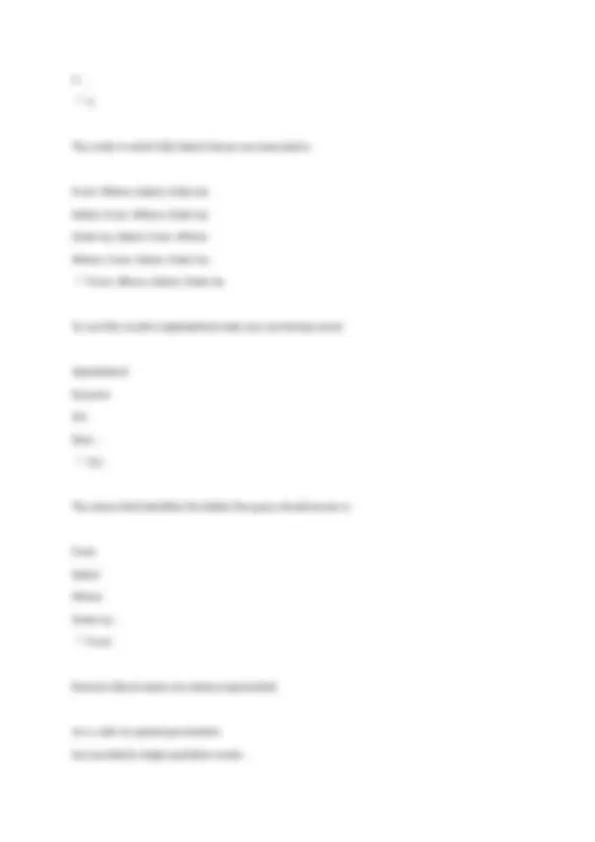

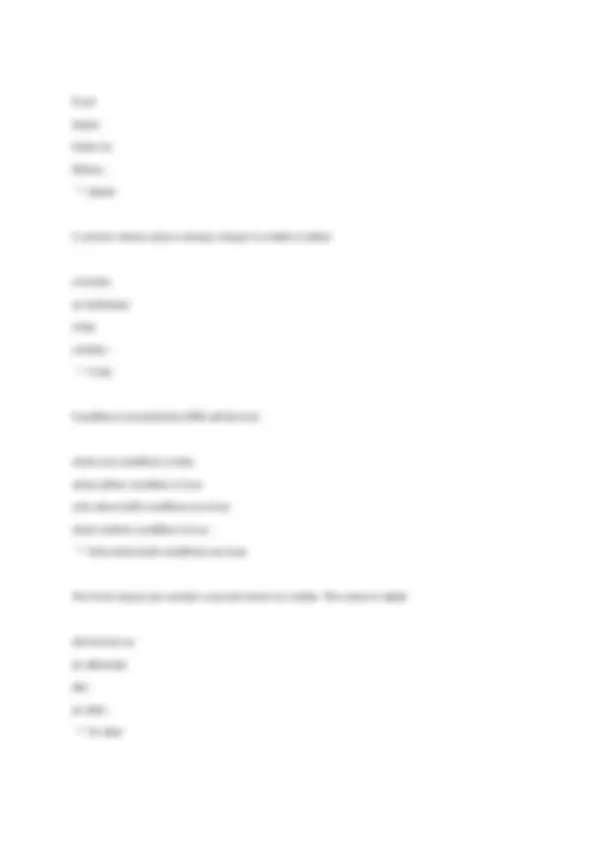
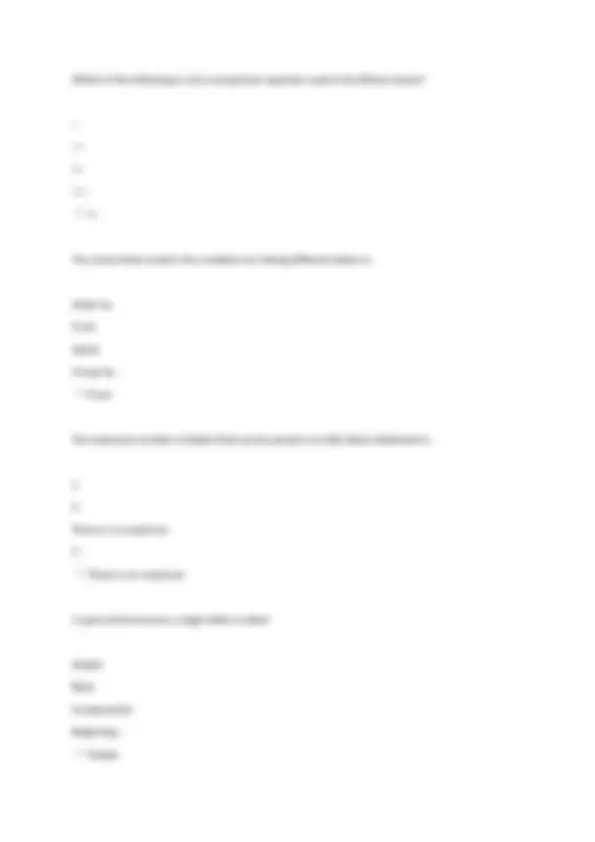

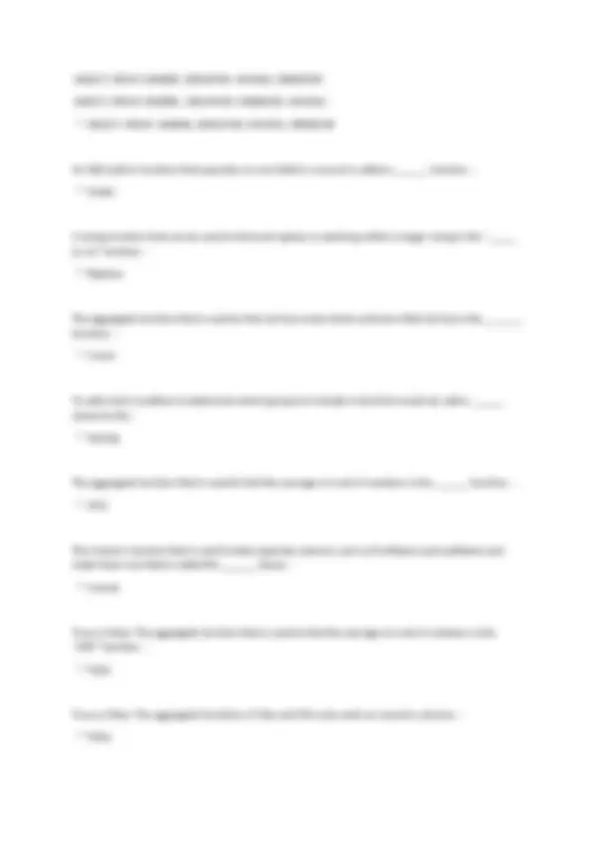
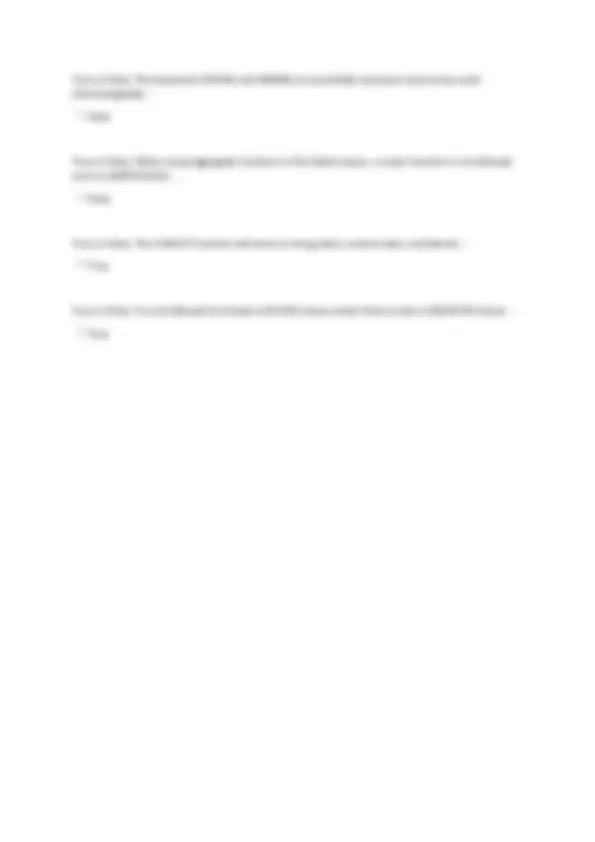


Study with the several resources on Docsity

Earn points by helping other students or get them with a premium plan


Prepare for your exams
Study with the several resources on Docsity

Earn points to download
Earn points by helping other students or get them with a premium plan
Community
Ask the community for help and clear up your study doubts
Discover the best universities in your country according to Docsity users
Free resources
Download our free guides on studying techniques, anxiety management strategies, and thesis advice from Docsity tutors
MIS 180 SDSU Meader SQL Exam 75 Questions and Answers
Typology: Exams
1 / 14

This page cannot be seen from the preview
Don't miss anything!









In a database table, a column or set of columns which are used to uniquely identify each row is a called what? An attribute A calculated field A key An identifier - ** A key Typical relational DBMS's in use today include all of the following EXCEPT... Symantec PostgresSQL DB MySQL - ** Symantec What is DBMS Data Security concerned with? Enforcing restrictions about who is able to access what data Ensuring that the data center is secure from intrusion Protecting against malware and other viruses Protecting against SQL injection attacks - ** Enforcing restrictions about who is able to access what data In the database approach to information systems, which of the following is NOT one of the responsibilities of the application software?
Define the schema. Send a request to the DBMS Provide complex functionality. Format and display the results. - ** Define the schema What is a recursive relationship? A relationship that is implied but not directly defined A relationship between a parent and child entities A relationship between distinct instances of the same entity A relationship that is not valid - ** A relationship between distinct instances of the same entity What are two of the most important pieces of information stored in a database about an entity? Identifiers and Attributes Field sizes and values Attributes and Relationships Identifiers and Relationships - ** Attributes and Relationships Which is NOT one of the responsibilities of a DBMS? Display query results Ensure data integrity Define the data Execute queries - ** Display query results
The order in which SQL Select clauses are executed is: From, Where, Select, Order by Select, From, Where, Order by Order by, Select, From, Where Where, From, Select, Order by - ** From, Where, Select, Order by To sort the result in alphabetical order you use the key word Alphabetical Numeric Asc Desc - ** Asc The clause that identifies the tables the query should access is: From Select Where Order by - ** From Numeric literal values are always represented As is, with no special punctuation Surrounded by single quotation marks
Literal values are not allowed Surrounded by double quotation marks - ** As is, with no special punctuation The clause that says which columns to list in the query result is: Order by Where Select From - ** Select To sort the result in alphabetical order you use the key word Desc Alphabetical Numeric No key word is needed - ** No key word is needed Which of the following is not a comparison operator used in the Where clause?
<> <= != - ** != Which of the following do you use to override the normal precedence of AND, OR, and NOT? Parentheses
True or False: != is not a comparison condition used in the Where clause. - ** True True or False: The default sort order of a query result is ascending by the first column in the Order by clause. - ** True True or False: To eliminate duplicate values, you put into the Select clause the key word Distinct. - ** True True or False: To override precedence of AND, OR, and NOT, use parentheses. - ** True The process of linking records in different tables is called concatenating linking connecting joining - ** Joining Conditions connected by OR will be true when either condition is true only when both conditions are true when both conditions are false only when just one condition is true - ** When either condition is true The clause that says which columns to list in the query result is:
From Select Order by Where - ** Select A column whose value is always unique in a table is called a locator an individual a key a finder - ** A key Conditions connected by AND will be true when one condition is false when either condition is true only when both conditions are true when neither condition is true - ** Only when both conditions are true The From clause can contain a second name for a table. This name is called also known as an alternate aka an alias - ** An alias
Conditions connected by OR will be true only when _____ are true (both/either/neither) - ** Both The clause that identifies the tables the query should access is the ______ clause. - ** From The From clause can contain a second name for a table. This name is called a(n) _____. - ** Alias The process of linking records in different tables is called _______ the tables. - ** Joining The clause the gives the condition for selecting rows is the ______ clause. - ** Where True or False: There is no maximum number of tables that can be joined in an SQL Select statement.
Date functions can appear in which clauses? Where and Select Where and Order by Where and From Where and Having - ** Where and Select What does the following statement return in Oracle: "EXTRACT(MONTH from PurchaseDate)"? -An integer for the month of the purchase date such as 9 -An abbreviation of the description of the month, such as SEP -A description of the month of the purchase date, such as September -An error because the syntax is incorrect - ** An integer for the month of the purchase date such as 9 What function or operation do you use to concatenate string fields in the answer table? -Use the concat function without commas but with '+' -Use the '+' between the fields with no commas between names -Use concat function with commas between names -Use the '+' bewteen fields with a comma - ** Use concat function with commas between names To find and replace a substring in a larger string use the following String function: -FINDREP (x,f,t) where t is original string, f is the new substring, x is the old substring -REPLACE (x,f,t) where x is original string, f is the new substring, t is the old substring -REPLACE (x,f,t) where t is original string, f is the new substring, x is the old substring -FINDREP (x,f,t) where t is original string, x is the new substring, f is the old substring -
An SQL built-in function that operates on one field in a record is called a ______ function. - ** Scalar A string function that can be used to find and replace a substring within a larger string is the "_____ (x,f,t)" function. - ** Replace The aggregate function that is used to find out how many total customers Red Cat has is the _______ function. - ** Count To add a test condition to determine which groups to include in the final result set, add a ______ clause to the - ** Having The aggregate function that is used to find the average of a set of numbers is the ______ function. - ** AVG The Column function that is used to take separate columns such as FirstName and LastName and make them one field is called the ______ clause. - ** Concat True or False: The aggregate function that is used to find the average of a set of numbers is the "AVE" function. - ** False True or False: The aggregate functions of Max and Min only work on numeric columns. - ** False
True or False: The keywords HAVING and WHERE are essentially synonyms and can be used interchangeably. - ** False True or False: When using Aggregate functions in the Select clause, a scalar function is not allowed, such as SQRT(AVG(x)). - ** False True or False: The CONCAT function will work on string data, numeric data, and literals. - ** True True or False: It is not allowed to include a HAVING clause unless there is also a GROUP BY clause. - ** True